The best Apple Watch apps for 2023
The best Apple Watch apps for fitness, travel and more
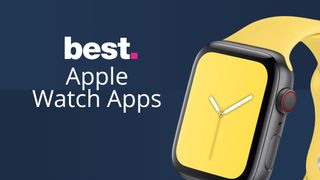
The best Apple Watch apps keep changing, as new apps keep launching and old ones are updated or improved, and this is testament to how rich the Apple Watch app scene is.
It wasn't always like that. Not too long ago, it seemed as if the Watch had lost its sparkle, with many big-name apps either languishing or being pulled from the Watch altogether - but now it seems that things are much more vibrant in the Watch app space.
You see, the problem was one of function - app developers spending too much time wondering 'could we make an Apple Watch app?' and not 'should we...?'
But Apple has pushed to improve the situation, with a big step coming with the arrival of an App Store directly on the Apple Watch with watchOS 6. In the years since then, the quality of Apple Watch apps has only improved, and while the selection isn't as rich as for the iPhone, it's the healthiest app ecosystem for a wearable.
So whether you've recently strapped on an Apple Watch 8 or are rocking an older Apple Watch, apps can help you get more out of it, and there are plenty to choose from.
We've made making that choice easier, as we've highlighted the very best Apple Watch options. Our favorite apps - the list of which is ever-growing - exist because they’re useful, or because they’re entertaining, or because they make your life that little bit better.
In this round-up you’ll find apps for podcasting and procrastinating, for getting fit and getting stuff done, for messing around and for sorting stuff out.
So whether you're new to watchOS or just want to refresh your stock, dive in and start getting the most out of your Apple Watch, and make sure to check this article regularly, as we'll add a new app every couple of weeks, highlighted below.
Best new Apple Watch app: Countdowns
Why you can trust TechRadar
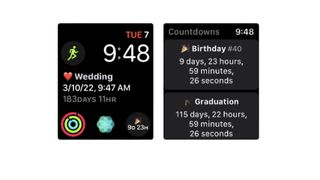
- Countdowns
- Free / IAPs
Your Apple Watch is pretty good at setting alarms, reminders, and timers, but what about countdowns to things such as birthdays, weddings, or your favorite band’s concert? Or what if you’re tracking the days since your last cigarette or alcoholic drink? The Countdowns app is here for all those things and more.
The core app is free, and works on Apple Watch, iPhone, iPad, and Mac. It gives you unlimited countdown timers, repeating timers for things such as birthdays, dark mode support, and the ability to import events from your Calendar.
If you want more features a small subscription or one-time purchase (currently $19.99 / £17.99 / AU$30.99) unlocks iCloud sync between devices, lists to organize multiple countdowns by event or category, directional indicators to make it clear whether a timer is counting up or down, and custom notifications to ensure you don’t miss anything important.
The app is a little basic on the Apple Watch – you can view the current countdown in a watch complication or open the app to see a scrollable list – but it’s effective enough; the countdown creation takes place on iPhone where it’s more convenient, and where you can also add countdown widgets to your lock screen and home screen.
Best Apple Watch apps for fitness and health
There's no denying that the main thrust of the Apple Watch since the second model is for fitness: it's packing GPS, heart rate, water resistance and improved sensors to make the most of the fact people like to work out with this thing - it even connects to gym equipment.
This list of Apple Watch fitness, running, wellbeing and health apps are nearly all must-have - if you're going to do one thing with your new Watch, use it to become a healthier you in mind and body.
Runance

- Runance
- Free
There are lots and lots of Apple Watch apps for runners on the App Store, but many of them are very focused on sharing – whether that’s leaderboards or comparing your stats with other runners near you – and the ones that don’t charge a subscription may be targeting you with ads instead.
Sharing’s great if you want it, but what if you’d rather keep your running data and preferred routes private? That’s what Runance was created for. It’s designed to be simple, effective, and privacy-focused, so the only data sharing it does is with the Health app on your iPhone.
Runance isn’t as complex as many other rival apps, but it covers the essentials just fine and has a simple, easy to read interface. You can switch between rolling and average tempos by tapping on the face, manually or automatically pause workouts when it’s time for a break, keep an eye on your heart rate, training zone, distance, tempo, and elapsed time, and you can also control your music or podcast player without leaving the Runance app. If you’re looking for a running app with a no-frills, no-ads, no-selling-your-data approach, Runance could be the perfect one for your watch.
Oceanic+
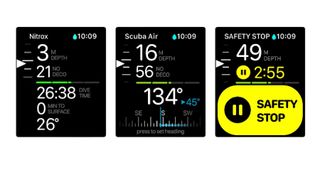
- Oceanic+
- Various subscription options
This is a very specific kind of app for one specific Apple Watch: the Apple Watch Ultra. That’s because only the Ultra is tough enough for the kind of diving that the Oceanic+ dive computer app has been designed to monitor. With the Oceanic+ app installed, your Apple Watch Ultra is a fully-fledged diving computer.
Designed for snorkeling, scuba, and surface diving, this is a kind of Swiss Army knife for underwater exploration. There’s a pre-dive location planner that tells you the surface and water conditions including water temperature, visibility, and currents; a planner to calculate your dive depth and duration; GPS-enhanced post-dive recording, and of course, clear and accurate monitoring of crucial metrics during your dive.
There are even complications you can use to display your post-dive data in whatever watch face you prefer. At heart, though, this app is about safety rather than style: its job is to make sure you have all the information you need before and during your dive.
Although the app is free to install, it’s subscription-based: you can choose from $0.99/£0.89 for a single day, $9.99/£8.99 a month or $79.99/£76.99 for an annual subscription.
Gentler Streak
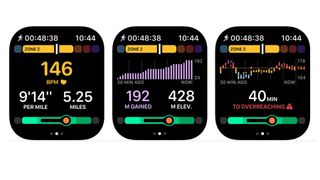
- Gentler Streak
- Free / IAPs
We’ve written about Gentler Streak before, but it’s just been given a major update (and Apple’s approval, via a cameo in this year’s WWDC keynote). The update makes it even better and adds full support for the latest versions of watchOS and iOS.
Gentler Streak is a fitness tracker and motivator that, as the name suggests, is designed to be less punishing and more friendly than most, keeping you within your ideal daily activity levels without overdoing it. It feels more human than many other fitness trackers, and understands that rest days are just as important as active ones.
The version 2.5 update adds some useful new features including new workout views and heart rate charts – the latter with a countdown to the goals of Go Gentler or Overreaching. As before it tracks over 85 different activities, including sports such as football and basketball, and there are complications to embed your status into various watch faces.
If you’re a dedicated gym rat permanently pushing yourself to achieve new personal bests, this probably isn’t the app for you. But if you want to work on your fitness and general health without overdoing it, Gentler Streak is, well, a much gentler alternative to the more hardcore fitness apps in the App Store.
Cronometer
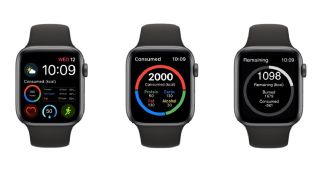
- Cronometer
- Free/IAPs
Counting calories is so last century. These days it’s all about the micronutrients – up to 82 of them – so you can develop a much more accurate picture of your nutritional needs and whether you’re meeting them. The Cronometer iPhone app already syncs with devices and apps from the likes of Fitbit, Withings, Strava, Garmin, Polar and more, and now it has an Apple Watch companion app too.
The Watch app is largely a display for the iPhone app, enabling you to see your progress and nutritional breakdown both in the app and via complications for watch faces.
In addition to micronutrient tracking, the key selling point here is accuracy. Cronometer uses lab data for all its nutritional information, and user submissions for new food items are evaluated for their accuracy before being added to the database.
The app covers all the features you’d expect from a nutrition tracking app: water and alcohol intake monitoring, barcode scanning, carb and cholesterol tracking, restaurant food logging and so on. The core features are free but there’s a paid tier that removes the ads and adds scheduling and customization options.
WatchTo5K
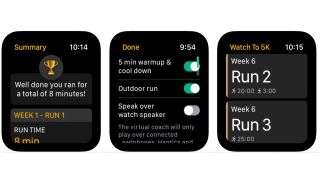
- WatchTo5K
- $3.99 / £3.49 / AU$5.99
We’ve covered this excellent fitness app before but version 3, launched in June 2022, is a significant update. The biggest difference is that in a reversal of the usual path, the Watch app now has an iPhone companion app that you can use to track your progress, earn achievements, and share your runs with other people.
The core Watch app has been given a slight redesign but retains its original appeal: it’s designed for absolute beginners who want to work towards running a 5K over a period of 9 weeks, for which it creates a training plan involving three runs per week. Once completed, you should be able to achieve your 5K in under 30 minutes.
The app provides key metrics such as distance traveled, average pace, calories burnt and heart rate, and all the details of your workouts are stored in Apple’s Health app. It also integrates with Apple’s Fitness app to record your runs and have them count towards your wider fitness goals, and you can record your route to review it later. We liked this app a lot in its previous incarnation and version 3 is a big improvement – without an accompanying big price tag. Where many running apps expect you to subscribe, WatchTo5K has a one-off price of just $3.99 / £3.49 / AU$5.99.
Heart Hive

- Heart Hive
- Free or a $4.99 / £4.49 IAP
While Apple now includes sleep tracking as part of watchOS, there’s still room for improvement, and plenty of third-party apps are offering more sleep tracking features than Apple provides.
The latest version of the popular NapBot sleep tracking app includes a particularly interesting feature: sleep apnea detection. Sleep apnea is a sleep disorder that means your breathing pauses or becomes very shallow more frequently than other people, and it can seriously disrupt your sleep – which means you’ll be more tired the next day.
NapBot can detect apnea via the respiratory rate measurement on your watch, which is enabled whenever the sleep focus mode is on. It also monitors environmental audio so you can see if external factors are contributing to poor sleep, and as you’d expect it provides the usual analysis of your sleep states.
The core app is free but you can also unlock a Pro subscription for $0.99 / £0.99 a month or $9.99 / £9.99 annually. That gives you two extra features: Sleep History and Sleep Trends, both of which enable you to see the big picture of your sleep habits and the effects of any lifestyle changes.
Water tracker - Waterful

- Water tracker - Waterful
- Free / IAPs
One of the things the Apple Watch is really good for is tracking little things, the kind of things you probably wouldn’t reach for your phone to record. For example, its automated workout detection means we record fitness data we wouldn’t otherwise think about. It’s the same with things like hydration: we really can’t be bothered picking up our phone to track every single bottle of water or cup of coffee, but we’re happy to quickly tap our Apple Watch while we sip.
Waterful isn’t the only hydration tracker on the App Store, but it’s one of the friendliest: we particularly like the main display, which uses a nice design to show you exactly what you’ve been filling yourself up with and how well you’re doing against your daily hydration target.
It integrates with the Health app and Siri Shortcuts, and it’s also available as complications for compatible Watch faces, so for example you can have a circular dial in the center or a percentage and total in a larger complication.
The core app is free to try and subscription-based if you decide to stick with it; you can pay monthly at $0.99 / £0.99 / AU$1.49 per month, but a lifetime subscription is only $9.99 / £8.99 / AU$14.99.
Tempo: Run & Walk Fitness Log

- Tempo: Run & Walk Fitness Log
- Free / IAPs
Tempo is popular with runners and walkers thanks to its intelligent analysis and excellent Apple Watch integration: it can get data from any fitness tracking app that logs data to Apple’s Health app, and then provide analysis of your performance. We’re pleased to see that the app also works for wheelchair users.
Earlier this year the app added Personal Bests to show you your fastest times, and in the latest update Tempo has added Goals. Goals enable you to set a distance goal, and that goal can be for a single workout or for multiple ones.
So for example if you’d like to follow the lead of The Proclaimers to walk 500 miles and then walk 500 more, you can set that goal in Tempo and it’ll track your progress even if you use other apps to monitor your walk or run in real time.
The app enables you to tag your workouts in all kinds of ways: you can even see if a particular pair of running shoes have affected your performance. You can also add Tempo calculations to many of your Apple Watch faces so you can see your progress.
Like most fitness tracking apps Tempo is subscription-based, but unlike many there isn’t a confusing range of options: there’s a single subscription plan of $9.99 / £9.49 / AU$15.99 per month.
Heart Analyzer
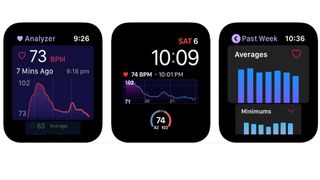
- Heart Analyzer
- Free / IAPs
We featured version 7 of Heart Analyzer back in 2019 and liked it a lot. Version 8 is new for 2020 and it’s a very big update – especially on iPhone, where it has a brand new and very nice user interface.
Unfortunately the Apple Watch’s display is rather limited compared to the phone, but while the Watch component isn’t quite as pretty as the new iPhone app, it’s still very effective and makes good use of the available space.
On your wrist, Heart Analyzer v8 comes with improved, customizable complications for the Infograph faces so that you can have your heart rate chart right there in front of you. The Watch app offers live heart rate monitoring and trend charts, weekly metrics and workout views, and it can also record calories burned and distance traveled. As you’d expect, it integrates well with Apple Health.
Things are even more impressive on iPhone, where you can view personalized metrics such as day/night resting heart rates, average heart rates, and historical data going back years. The new interface makes everything much clearer and achieves the tricky balance of giving you lots and lots of data without being overwhelming.
Strava: Run & Ride Training
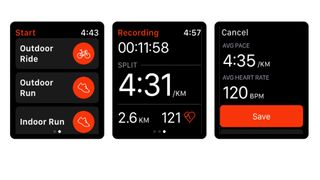
- Strava: Run & Ride Training
- Free with in-app purchases
Strava needs no introduction for serious fitness fans: it’s one of the world’s top fitness apps for runners, cyclists and swimmers, as well as gym-goers, kayakers and yoga practitioners. The latest version brings proper support for the Apple Watch, enabling you to sync workouts and activities you’ve recorded with Apple’s Workout app with the Strava app and its online tracking, to build a better overall picture of your fitness activities.
Strava is on a constant update cycle, so just days after the Apple Watch sync was introduced there was another update with improved stroke analysis for swimmers and better cadence analysis for runners; two weeks previously there were new features for skiers and for activity sharing, as well as a bunch of interactive 3D maps.
The big selling point of Strava is its social aspect, which elevates it above other GPS-enabled fitness apps: you can compare your performance not just with yourself but with other users, you can compete to become the king or queen of particular geographical leaderboards, and you can share with friends and followers to get encouraging words and helpful feedback.
The best bits are in the Premium subscription, which is fairly cheap by fitness-app standards: it’s currently $5.99/£5.99/AU$9.99 a month or $59.99/£44.99/AU$89.99 a year.
Hole19 Golf GPS & Scoring
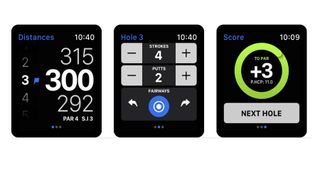
- Hole19 Golf GPS & Scoring
- Free (in-app purchases)
Hole19 claims to be the most-used golf GPS range finder in the UK, with more than 10 million rounds registered, and it claims to be as accurate as a real caddie – although it doesn’t specify which one.
As is usually the case with sports apps the bulk of the work is done by the iPhone app, with the Apple Watch companion providing just the essential features and information you need while you’re on the green.
The main app offers two key tools: GPS range finding so you can see how far you are from your goal as well as any hazards, and a digital scorecard that you can use to track your stats over time.
On your watch, it shows you the distance to the front, center and back of the green; swipe and there’s an input screen where you can track your performance. It’s all very simple and straightforward, enabling you to track your playing without distracting you for too long.
The usefulness of the app depends mainly on whether it knows about the course(s) you want to play. Hole19 knows over 42,000 courses in 201 countries, so yours should be covered, but the app’s free to try so you can make sure it’s right for you before signing up for a subscription.
Swing Tennis Tracker
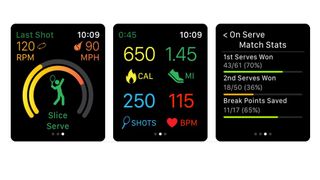
- Swing Tennis Tracker
- Free/IAPs
Built for serious tennis players under the guidance of Andy Roddick and James Blake, Swing Tennis Tracker is designed to analyze your swings as well as record your stats. It isn’t just a solo app: it can also sync scores with other Apple Watch users on the court. There’s excellent Siri integration for starting matches and practice, integration with the Activity and Health apps, and excellent visual feedback to show you how hard you’re hitting.
The Watch component concentrates on the recording and feedback, while the phone app takes care of scores, stats and video, as well as providing action advice after each hit. It’s a great app for individual players but it can also be used by parents, coaches and in teams, to track others’ performance too.
There are two subscription plans, the $4.99/£4.49/AU$7.99 per month Premium and the $9.99/£9.49/AU$15.49 Pro. The former unlocks historical statistic graphics, head-to-head records against non-Swing users and unlimited analysis graphs for each session, while the Pro subscription adds video lessons from tennis pros and intelligent analysis of your performance that identifies key areas for improvement after each session.
Nike Run Club

- Nike Run Club
- Free
The ongoing love-fest between Nike and Apple continues to bear fruit: the latest iteration of the Nike Run Club app introduces some welcome improvements.
It now integrates with Siri Suggestions, which means the app can now suggest good times for a run based on your previous runs (the feature is off by default so it won’t nag you if you don’t want it to), and there are new Apple Watch complications including one for the Infograph face that shows how far you’ve run this month.
There’s hardly a shortage of running apps in the App Store but Nike’s budget is a bit higher than most, so the app feels a lot more premium than many others. It tracks and stores all your runs thanks to your Watch’s built-in GPS, enables you to listen to audio guides as you run, offers a range of challenges to keep you motivated and has good social sharing features, so you can turn your friends into cheerleaders.
It’s very well designed and the Watch app doesn’t sacrifice substance for style: while visually it’s very attractive it also shows all the information you actually need as you’re pounding the pavements. It’s a really good running app.
Nike Training Club
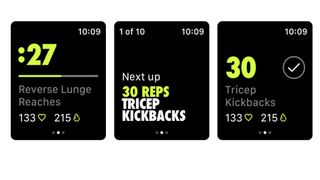
Nike and Apple are best friends forever, so it’s not a huge surprise to see Nike unveil another Watch app. This one’s really good, too. Describing itself as “your ultimate personal trainer”, Nike Training Club has more than 180 workouts covering strength, endurance, mobility and yoga, and they’re all free. There are daily personalized picks based on your previous activity, flexible training plans to help you achieve your fitness goals, and tips from top trainers.
The app splits jobs between phone and Watch. The former is where you do the planning and tracking; the latter is what you wear while you’re actually working out. By necessity as well as design that means focusing only on the information you really need right now, such as your heart rate and how many reps you still have to do before you can undo all your efforts with some cake and beer.
The app is by no means unique in its combination of Watch and workout tracking, although it does have Nike’s immediately recognizable and individual visual style. But what’s significant about this app is that none of its many workouts are hidden behind in-app purchases or pricey subscriptions. Everything in the app is free.
Headspace
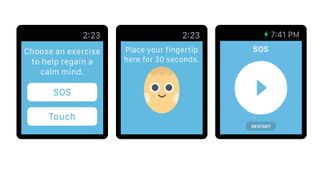
- Headspace
- Free + in-app purchases
If you’ve ever felt that life is just that bit too busy or stressful, Headspace could help. It’s based around mindfulness, which is all about getting you to feel calmer without too much effort. In fact, it’s the opposite of effort: mindfulness is about taking a break from the rush.
The Apple Watch app is part of a wider offering for iPhone and iPad: it acts as a reminder and a coach, urging you to pick an exercise and focus on it for the allotted time. It also has an SOS mode for when things feel too much and you need help instantly. But it’s the main app that does most of the work, with daily mindfulness exercises and sessions designed to help with everything from workplace stress to sleep problems.
It’s very well done but one thing that might raise your stress levels is the cost: while the app is free to try it really needs a subscription to unlock its most useful features, and that subscription is $12.99/£9.99/AU$19.99 per month or $94.99/£74.99/AU$149.99 per year. That’s an auto-renewing subscription too, so you need to disable that in iTunes if you don’t want it to recur automatically.
Streaks

- Streaks
- $4.99/£4.99/AU$7.99
The trick to living better isn’t to damn near kill yourself on a treadmill and then give up after a few weeks. It’s to make smaller, lasting changes to your life, changes that you can and will actually stick to. And that’s what Streaks offers.
Whether you’re trying to eat more healthily, exercise more or break a smoking habit, Streaks enables you to track positive and negative habits. It offers a range of reporting tools so you can see exactly how well you’re doing, and you can track up to 12 different tasks at once.
They needn’t be exercise or eating tasks: you can remind yourself to walk the dog, study, take vitamins or practice a musical instrument. It’s good to see wheelchair users included in the default tasks list too.
Where Streaks really shines is in its integration with the Health app, which enables it to pull data to use for monitoring suitable targets you’ve set. That reduces a lot of the form-filling of similar apps, and it’s particularly effective if you’re trying to work on good healthy habits or eliminate unhealthy ones, or both.
There’s a Complication too, so that you don’t forget your goals, and the whole thing is customizable so that you can get it just-so.
MyFitnessPal
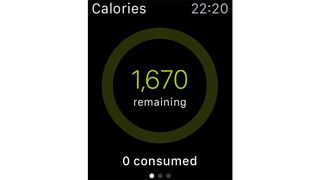
- MyFitnessPal
- Free + IAPs
Information is power and if you're trying to lose weight, calorie tracking is a good way to stay focused. MyFitnessPal works out a daily calorie allowance based on how much weight you want to shed. Eat a meal and your allowance is spent, take exercise and you earn credit.
The Watch gives you a running total of remaining calories and how that breaks down into protein, carbohydrates and more. It can integrate with your steps total so you don't have to add those manually. It's simple but convenient and helpful.
CARROT Fit

- CARROT Fit
- $3.99/£3.99/AU$5.99
You may know CARROT from its weather app, which combines Dark Sky-style weather forecasting with sarcasm and lies. But CARROT wants to make you unhappy in many other ways - and what’s better for a sadistic AI than being in control of a fitness app?
Enter CARROT Fit, which takes a somewhat unusual approach to motivating you to get healthier and lose weight.
CARROT promises to “get you fit - or else”. To achieve that it offers a dozen punishing exercises (more are available via in-app purchases) accompanied by threats, ridicule, bribes and the occasional compliment.
It’s rude, crude and much more entertaining than trying to complete the rings on Apple’s own activity tracker, and we’re pretty sure it’s the only fitness app that rewards progress with cat facts. But there’s a proper fitness tracker in here too: it’ll track your steps and weight loss, remember your workouts and add data to Apple’s health app.
Most of the personality is in the main iPhone app, but the Watch alerts include such cheery prospects as “seven minutes in hell”. If you find getting fit or losing weight a little bit tedious, CARROT might be the, ahem, carrot that you need to get motivated.
How we test Apple Watch apps
We go through hundreds of apps every year looking for the best to recommend you pick up for your Apple Watch. We use the Apple App Store, developers, online resources and more to find the top choices that we should trial.
Then we take those apps, and use them in our everyday lives to see how they work and whether they're worthy of a place on this list. Our writer who handles this list is always trying out brand new Apple Watch apps almost every day.
What apps can you put on your Apple Watch?
That's more limited than your iPhone, iPad or Mac as there aren't as many services designed for the Apple Watch's smaller screen. There are still thousands to choose from, and hopefully our rankings here should help you pick out the best services for you.
How many Apple Watch apps are there?
That figure is always changing, but there are over 20,000 with more developers putting services onto the App Store every day. You'll have over 40 apps downloaded to your Apple Watch immediately, too.
Current page: Best new entry and best Apple Watch fitness apps
Next Page Best Apple Watch sleep apps and music appsGet daily insight, inspiration and deals in your inbox
Get the hottest deals available in your inbox plus news, reviews, opinion, analysis and more from the TechRadar team.
Writer, broadcaster, musician and kitchen gadget obsessive Carrie Marshall (Twitter) has been writing about tech since 1998, contributing sage advice and odd opinions to all kinds of magazines and websites as well as writing more than a dozen books. Her memoir, Carrie Kills A Man, is on sale now. She is the singer in Glaswegian rock band HAVR.


